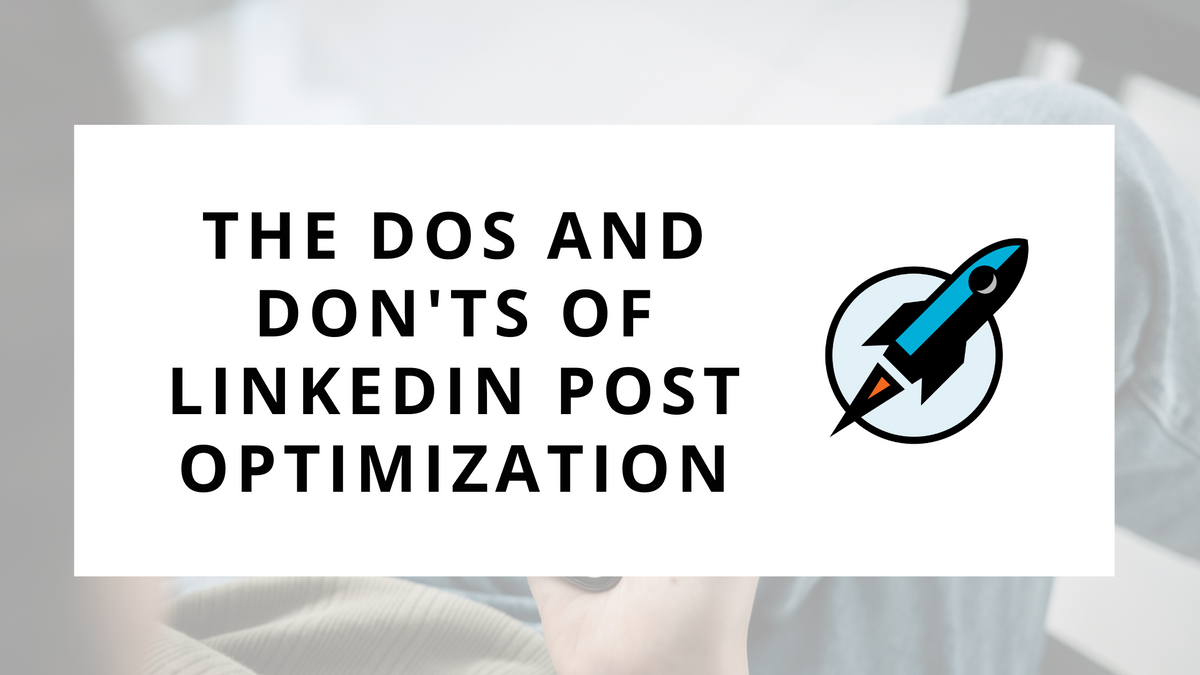Maximize Your Reach: The Dos and Don'ts of LinkedIn Post Optimization

Ahh, the algorithms.
They giveth, and they taketh away.
The ability for you to execute a social selling strategy is often dependent on your ability to successfully navigate social media algorithms.
Which, quite frankly, can be quite challenging to do. They are all continually changing to try and strike a balance between reach, quality content, benefits to creators, benefits to advertisers, and benefits to the end users.
In this edition of Sell With Social, I want to provide tips on best navigating the LinkedIn Algorithm in 2023.
Don’t Sacrifice at the Alter of Algorithm
But before we dive into the dos and don’ts of the LinkedIn algorithm, I want to make a quick public service announcement.
Don’t sacrifice your strategy at the alter of the algorithm.

Yes, the algorithm does matter. But you shouldn’t build your entire content strategy around what would be good for the algorithm.
Don’t let the tail wag the dog.
Your strategy, including your content, target audience, and brand positioning, should drive your decisions. The algorithm should then be applied AFTER to optimize for additional reach.
I see it all too often where a person focuses more on pleasing the algorithm than creating quality content that engages their audience.
I promise you, that won’t work.
Alright, now on to the dos and don’ts!
The Dos of the LinkedIn Algorithm
Let’s start with what HELPS your posts do better on the LinkedIn Algorithm. The following tactics have been shown to help with increasing the impressions of your content on LinkedIn:
Write Engaging Headlines: Create compelling headlines (the first few sentences) that pique curiosity and encourage people to click on your post to read more. The more people click “see more,” the more reach your posts will have.
Write Concisely and Clearly: Keep your posts short, easy to read, and focused on the main point you want to convey. Avoid jargon and use simple language.
Include a Call-to-Action (CTA): Encourage your audience to engage with your post by adding a clear CTA. For example, ask them to like, comment, share, or follow your page. Clicks are seen as an endorsement of quality. Note: CTAs to external sites will hurt links. So create CTAs that are engagements to the post itself.
Tag Relevant People and Companies: If your post mentions or features someone else's work, tag them in the post. This can expand your post's reach to their connections and followers (IF they engage with the post).
Use Hashtags Strategically: Incorporate relevant and trending hashtags in your post to increase its discoverability. However, avoid overusing hashtags, and ensure they are genuinely related to your content. I recommend using 1-3 hashtags at most.
Post at Optimal Times: Analyze your LinkedIn analytics to identify when your audience is most active, and schedule your posts accordingly to maximize visibility. This is Monday through Thursday between 8 AM and 4 PM for most people.
Engage with Commenters: Respond to comments on your post promptly and encourage further discussion. Engaging with your audience shows that you value their input and encourages others to join the conversation.
Share Valuable Content: Provide insights, tips, or valuable information in your posts. Content that educates, entertains, or solves a problem resonates well with LinkedIn users. Proofread and edit your content to be professional and enjoyable to read/view.
Repurpose Content: If you have a blog post, article, or video on another platform, adapt it for LinkedIn. Repurposing content allows you to reach a different audience on the platform.
Utilize LinkedIn Features: Use LinkedIn features like LinkedIn Live or document uploads to add variety to your posts. LinkedIn does seem to boost content that uses its more recent feature rollouts.
Use “Thumb-Stopping” Visuals - Use interesting visuals to stop people from scrolling. Including high-quality images, videos, or infographics in your posts can capture users' attention and make your content more shareable.
Post Consistently - LinkedIn tends to favor more recent content (last 24-72 hours). Regularly posting and engaging with your audience can help you maintain visibility and grow your LinkedIn presence.
Use Native Media - Post your media content (images, videos, documents) natively to LinkedIn. Linking to external content, for example, a YouTube video, will get far less engagement. LinkedIn wants to keep users on their native media viewers.
Optimize Your Profile - Make sure your actual profile is optimized. The algorithm will utilize skills, topics, experience, and headlines from your profile to categorize your content. Plus, your profile serves as the landing page for the social activity you do generate.
The Don’ts of the LinkedIn Algorithm
Now let’s talk about things you SHOULD NOT do. Below are some issues that can cause your reach to be limited:
Spammy Content: LinkedIn's algorithm is designed to identify and minimize spammy content. Overly promotional or irrelevant posts may be penalized, leading to reduced reach. If it feels spammy or overly salesy, don’t post it.
Excessive Hashtag Usage: While using relevant hashtags can be beneficial, using too many hashtags in your posts can make them look spammy and might result in lower reach.
Poor Quality Content: Low-quality content, such as posts with grammatical errors, irrelevant information, or clickbait headlines, is less likely to gain traction and reach a wide audience. Again, it’s all about providing value to your audience.
Inconsistent Posting: Irregular posting can make maintaining engagement with your audience challenging and may lead to decreased visibility in their feeds.
Duplicate Content: Posting the same content repeatedly or across multiple LinkedIn accounts may be seen as spam and could hurt your reach. If you have content you want to share in multiple locations, I recommend varying it slightly in each spot.
Ignoring Comments: Failing to respond to comments on your posts might discourage further engagement and reduce the reach of your content.
Sharing External Links: While it's acceptable to share relevant content from external sources occasionally, posting too many links to external sites might be seen as an attempt to redirect users away from LinkedIn, resulting in lower reach. If you need to use outbound links, you can also put them in the comments AFTER people have already engaged with the post.
Non-Engaging Content: Whether or not your audience engages with your post is a significant determinant of reach. The algorithm may deprioritize posts that do not generate meaningful interactions, such as likes, comments, and shares.
Misusing LinkedIn Live or Events: If you misuse features like LinkedIn Live or Events by sharing low-quality or irrelevant content, it may negatively impact your overall reach. Be sure you are going live with content that your audience will enjoy.
Negative or Controversial Content: LinkedIn tends to be a professional platform, so excessively negative or controversial content might alienate your audience and reduce your post's reach.

For this week’s action items, I don’t want you to focus on the algorithm. However, I do want you to be aware of the algorithm.
Here’s what you should do:
- Create Your Content - Create content for your audience that will educate, entertain, or inspire them. Make it quality, with relevant information, clear writing, and grammatically correct.
- Optimize for Reach - After creating your content, go back and do some high-level checks to ensure it's appropriately optimized for the algorithm. Are you doing anything that could hurt reach? Could you make any tweaks that would help reach?
At the end of the day, it's important to remember the algorithm’s goal - to keep its users engaged. If you, as a content creator, can create engaging content, it will try to show it.
